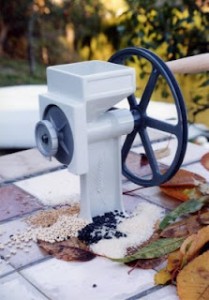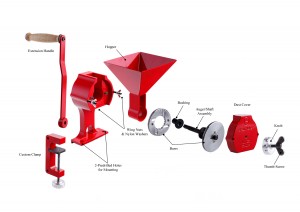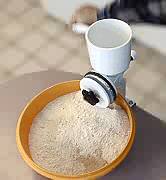Manual Grain Mill Basics or Grinder 101
When you buy a hand grain mill there are a number of factors to take into consideration. When choosing a grain mill consider your needs and requirements as well as the quality of the mill.
The Three Most Important Things About A Grinder:
- Flour Fineness: The most important thing about a grinder is how finely it grinds. If it doesn’t grind at least a little bit fine, you are never going to get a good loaf of bread out of it.
- Grinding Speed: There is a huge difference in how fast the different grinders process wheat into flour. Of course, the shorter the time, the better.
- Pressure Required To Crank The Grinder: There is also a huge difference between the grinders in how hard or easily they are turned. Logic would seem to say that it takes a given amount of energy to grind a cup of wheat to a certain fineness. The easier a grinder turns, the slower one would think it grinds–and vice versa. However, because of the different stone and burr designs, this is not the case. There is a great difference, between various grinders, in how much work must be expended to create the same texture of flour.
Unimportant Considerations:
- The Hopper Size: People with little or no experience with manual grain grinders incorrectly assume the hopper size is very important, thinking that if the grinder has a small hopper they are going to have to stop and fill the hopper more frequently. This is faulty thinking because it takes such a long time to grind a cup of wheat, even with the very best grinders. The time it takes to stop and throw another cup or two in the hopper amounts to nothing. Interestingly enough, one of the best grinders and the very worst grinder have the same hopper size. Don’t be fooled by this. Hopper size doesn’t matter.
- The Way It Looks: There are pretty grinders and there are ugly grinders. I’d a thousand times rather have an ugly, efficient grinder than a pretty piece of junk.
Ten cups of wheat makes approximately 14 cups of flour
The Controversy – Stones VS Burrs:Stones used to be made from natural rock but now are synthetically manufactured from aluminum oxide and various binders. Good burrs are made from carbon steel. You won’t find much controversy over burrs, but you will concerning stones.
Stones: I like a stone grinder because they give a finer grind than many burr grinders (though the Country Living Mill is an exception– a burr grinder that will mill an ultra-fine cake flour). Modern grinder stones are made from aluminum oxide. This includes the stones in the Little Ark, the Nugget, and the electric Golden Grain Grinder. Stones get a very bad rap for two reasons.
- Grit In The Flour: The American Dental Association has made a statement that’s often repeated by numerous dentists, “You shouldn’t use stone ground flour because the grit the stones leave in the flour will wear your teeth down.” This might be true of stone ground flour in the third world where native populations use two rocks to grind their meal, but it is not true of these modern grinders. Aluminum oxide stones are extremely hard. After the break in period, these stones wear down very slowly.
I’m told stories all the time by people who have motorized their manual grinders and from people who own electric grinders with aluminum oxide stones. They have individually put tons of wheat through their grinders over many years and their stones are still serviceable. My mom is just one example. Forty years ago when I was a little kid, she got what is now called the Golden Grain Grinder and has used it every week for making bread since then. The stones are still like new. Through all my growing years of eating her bread, I have never felt one piece of grit between my teeth.
I expect there have been people who pull their Little Ark or Nugget grinder out of the box, push the directions aside and grind up a cup of flour. Then they never use their grinder again because they found grit in the flour from this first grind. Both of these grinders need to be broken in by putting at least a quart of wheat through them, then discard the flour. After the stones are broken in, that’s the end of the grit.
- Health Concerns About The Stones’ Composition; Aluminum Oxide: Some claim that the aluminum oxide can’t be absorbed by our digestive systems, and many of us literally eat aluminum every day–as some baking powders are 1/3 alum, a form of aluminum. And many people use aluminum pots. There is valid reason for concern, however, as high amounts of aluminum have been found during autopsies of Alzheimer victims. There’s a hot debate today concerning the effects of aluminum on our health.
I’ve seen several people choose not to buy one of these grinders because of the aluminum oxide stones. There is a difference between aluminum and aluminum oxide. When these stones are made, the manufacturer starts out with the same material that aluminum is made from, bauxite. Bauxite is a red clay that’s dug out of the earth, then heated up to over 2,000 degrees C for several days until all that’s left is a cinder. This is what the stones are made from. See Treibacher Schleifmittel’s web page for more information on how aluminum oxide is made. A standard aluminum goes through a completely different manufacturing process. The bottom line is you will have to make up your own minds about this issue and go with a burr or impact grinder if you still feel aluminum oxide poses a health risk to you.
Cost VS Use: You may wish to temper your decision by the quality of grinder you will be spending your hard earned cash on, and by how much you think you will be using it. There’s got to be tons of people out there who have a manual grinder, have never used it, and depending on circumstances may never use it. Contrast this with the families who use a grinder every week to make bread, pancakes, rolls and other things with freshly ground flour.
Do you want a manual grinder that will only be used to get you through the tough scrapes or will you be using it all the time? Some people want the very best grinder made, whether they are going to use it a lot or not. Other people will purchase the least expensive grinder they can find–then learn that it won’t meet their needs when they begin to use it. Perhaps some real thought should be put into getting a grinder that will nicely serve the expected needs of your family, whatever they may be.
The Testing Process
Why A Ten Cup Grind? Turning a grinder for 2 or 3 revolutions is one thing. Grinding a full cup of wheat is a very different thing, and grinding enough wheat to make a nice batch of bread is quite another thing. We did a 10 cup grind so you could get some idea what these different grinders were like if you needed to make lots of flour with them.
Grinding Wheat Is Work: The first thing people need to know is that grinding wheat is a LOT OF WORK! Wheat is very hard stuff and it takes a huge amount of energy to turn it into soft, powdery flour. As the tests show, some manual grinders require much less energy than others.
Manual Grain Mill Basics or Grinder 101
When you buy a hand grain mill there are a number of factors to take into consideration. When choosing a grain mill consider your needs and requirements as well as the quality of the mill.
The Three Most Important Things About A Grinder:
- Flour Fineness: The most important thing about a grinder is how finely it grinds. If it doesn’t grind at least a little bit fine, you are never going to get a good loaf of bread out of it.
- Grinding Speed: There is a huge difference in how fast the different grinders process wheat into flour. Of course, the shorter the time, the better.
- Pressure Required To Crank The Grinder: There is also a huge difference between the grinders in how hard or easily they are turned. Logic would seem to say that it takes a given amount of energy to grind a cup of wheat to a certain fineness. The easier a grinder turns, the slower one would think it grinds–and vice versa. However, because of the different stone and burr designs, this is not the case. There is a great difference, between various grinders, in how much work must be expended to create the same texture of flour.
Unimportant Considerations:
- The Hopper Size: People with little or no experience with manual grain grinders incorrectly assume the hopper size is very important, thinking that if the grinder has a small hopper they are going to have to stop and fill the hopper more frequently. This is faulty thinking because it takes such a long time to grind a cup of wheat, even with the very best grinders. The time it takes to stop and throw another cup or two in the hopper amounts to nothing. Interestingly enough, one of the best grinders and the very worst grinder have the same hopper size. Don’t be fooled by this. Hopper size doesn’t matter.
- The Way It Looks: There are pretty grinders and there are ugly grinders. I’d a thousand times rather have an ugly, efficient grinder than a pretty piece of junk.
Ten cups of wheat makes approximately 14 cups of flour
The Controversy – Stones VS Burrs:Stones used to be made from natural rock but now are synthetically manufactured from aluminum oxide and various binders. Good burrs are made from carbon steel. You won’t find much controversy over burrs, but you will concerning stones.
Stones: I like a stone grinder because they give a finer grind than many burr grinders (though the Country Living Mill is an exception– a burr grinder that will mill an ultra-fine cake flour). Modern grinder stones are made from aluminum oxide. This includes the stones in the Little Ark, the Nugget, and the electric Golden Grain Grinder. Stones get a very bad rap for two reasons.
- Grit In The Flour: The American Dental Association has made a statement that’s often repeated by numerous dentists, “You shouldn’t use stone ground flour because the grit the stones leave in the flour will wear your teeth down.” This might be true of stone ground flour in the third world where native populations use two rocks to grind their meal, but it is not true of these modern grinders. Aluminum oxide stones are extremely hard. After the break in period, these stones wear down very slowly.
I’m told stories all the time by people who have motorized their manual grinders and from people who own electric grinders with aluminum oxide stones. They have individually put tons of wheat through their grinders over many years and their stones are still serviceable. My mom is just one example. Forty years ago when I was a little kid, she got what is now called the Golden Grain Grinder and has used it every week for making bread since then. The stones are still like new. Through all my growing years of eating her bread, I have never felt one piece of grit between my teeth.
I expect there have been people who pull their Little Ark or Nugget grinder out of the box, push the directions aside and grind up a cup of flour. Then they never use their grinder again because they found grit in the flour from this first grind. Both of these grinders need to be broken in by putting at least a quart of wheat through them, then discard the flour. After the stones are broken in, that’s the end of the grit.
- Health Concerns About The Stones’ Composition; Aluminum Oxide: Some claim that the aluminum oxide can’t be absorbed by our digestive systems, and many of us literally eat aluminum every day–as some baking powders are 1/3 alum, a form of aluminum. And many people use aluminum pots. There is valid reason for concern, however, as high amounts of aluminum have been found during autopsies of Alzheimer victims. There’s a hot debate today concerning the effects of aluminum on our health.
I’ve seen several people choose not to buy one of these grinders because of the aluminum oxide stones. There is a difference between aluminum and aluminum oxide. When these stones are made, the manufacturer starts out with the same material that aluminum is made from, bauxite. Bauxite is a red clay that’s dug out of the earth, then heated up to over 2,000 degrees C for several days until all that’s left is a cinder. This is what the stones are made from. See Treibacher Schleifmittel’s web page for more information on how aluminum oxide is made. A standard aluminum goes through a completely different manufacturing process. The bottom line is you will have to make up your own minds about this issue and go with a burr or impact grinder if you still feel aluminum oxide poses a health risk to you.
Cost VS Use: You may wish to temper your decision by the quality of grinder you will be spending your hard earned cash on, and by how much you think you will be using it. There’s got to be tons of people out there who have a manual grinder, have never used it, and depending on circumstances may never use it. Contrast this with the families who use a grinder every week to make bread, pancakes, rolls and other things with freshly ground flour.
Do you want a manual grinder that will only be used to get you through the tough scrapes or will you be using it all the time? Some people want the very best grinder made, whether they are going to use it a lot or not. Other people will purchase the least expensive grinder they can find–then learn that it won’t meet their needs when they begin to use it. Perhaps some real thought should be put into getting a grinder that will nicely serve the expected needs of your family, whatever they may be.
The Testing Process
Why A Ten Cup Grind? Turning a grinder for 2 or 3 revolutions is one thing. Grinding a full cup of wheat is a very different thing, and grinding enough wheat to make a nice batch of bread is quite another thing. We did a 10 cup grind so you could get some idea what these different grinders were like if you needed to make lots of flour with them.
Grinding Wheat Is Work: The first thing people need to know is that grinding wheat is a LOT OF WORK! Wheat is very hard stuff and it takes a huge amount of energy to turn it into soft, powdery flour. As the tests show, some manual grinders require much less energy than others.




